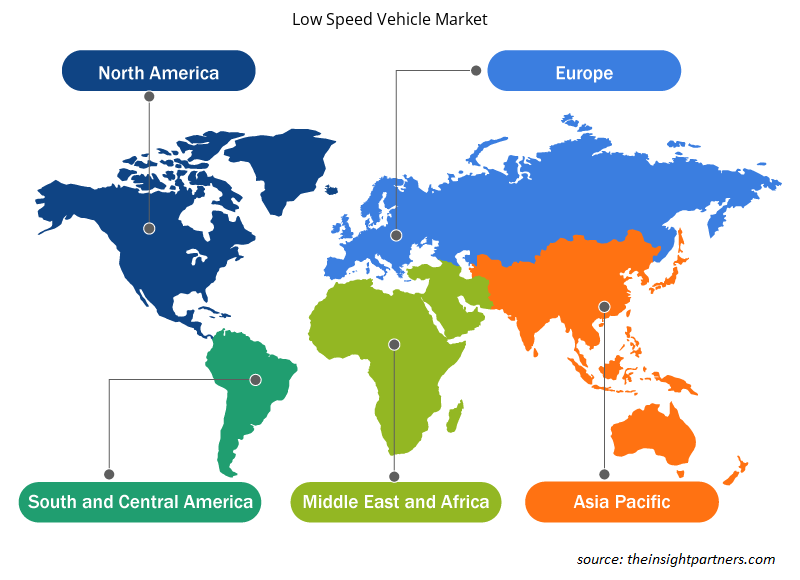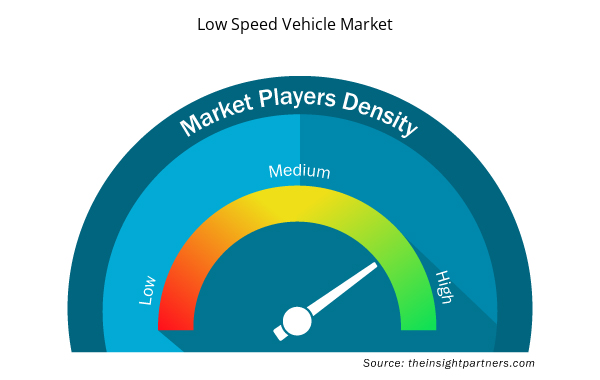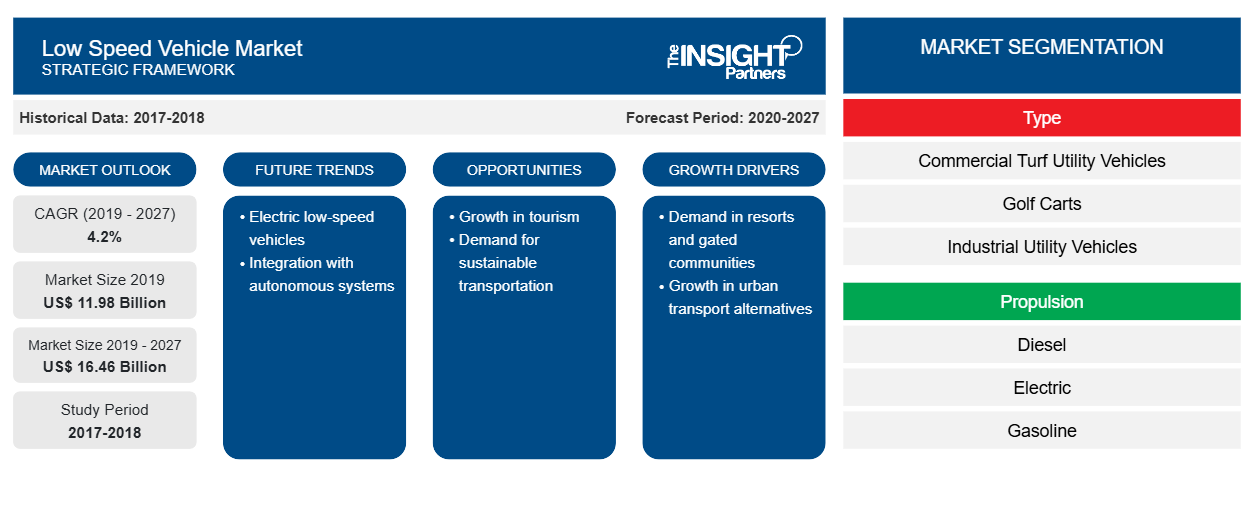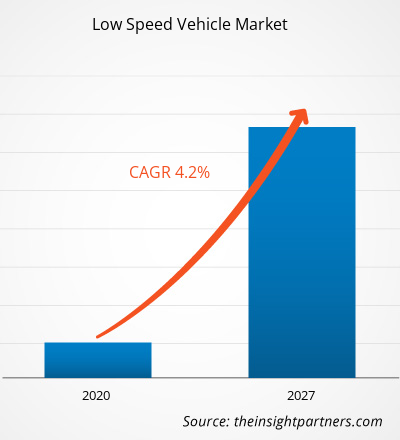بلغت قيمة سوق المركبات منخفضة السرعة 11.98 مليار دولار أمريكي في عام 2019 ومن المتوقع أن تنمو بمعدل نمو سنوي مركب قدره 4.2٪ من عام 2020 إلى عام 2027 لتصل إلى 16.46 مليار دولار أمريكي بحلول عام 2027.
شهد سوق المركبات منخفضة السرعة نموًا ملحوظًا في العامين الماضيين على مستوى العالم. تعد التوقعات الاقتصادية الإيجابية وارتفاع الدخول المتاحة والنمو السكاني من بين العوامل التي تدفع الطلب على مشاريع البنية التحتية. أيضًا، فيما يتعلق بحجم الطلبات عبر الإنترنت المرتفع، تنمو صناعة التجارة الإلكترونية مما يؤدي إلى زيادة ملكية المستودعات في المنطقة. تدعم المركبات منخفضة السرعة داخل المستودع نقل الصناديق من مكان إلى آخر. تلعب العوامل المذكورة أعلاه دورًا رئيسيًا في تسريع نمو سوق المركبات منخفضة السرعة . احتلت منطقة آسيا والمحيط الهادئ أكبر حصة سوقية في عام 2019 ومن المتوقع أن تكون أسرع منطقة نموًا في سوق المركبات منخفضة السرعة. تعد أمريكا الشمالية وأوروبا ثاني وثالث أكبر منطقة في سوق المركبات منخفضة السرعة.
بدأ تفشي فيروس كورونا في مدينة ووهان (الصين) خلال شهر ديسمبر 2019. وقد انتشر بسرعة كبيرة في جميع أنحاء العالم، ومن بين الدول الأكثر تضررًا الصين وإيطاليا وإيران وإسبانيا وجمهورية كوريا وفرنسا وألمانيا والولايات المتحدة. بدأ تفشي فيروس كوفيد-19 والآثار الناتجة عنه مثل إغلاق الحدود والإغلاقات وحظر السفر في التأثير على الشركات في مختلف الصناعات. ومن المتوقع أن يكون لسوق المركبات منخفضة السرعة تأثير متوسط بسبب الاضطرابات في سلاسل التوريد العالمية. ستشهد الشركات العاملة في هذا السوق انخفاضًا في المبيعات الإجمالية على المدى القصير (3-6 أشهر)، ومع ذلك، سيشهد السوق نموًا ثابتًا في السنوات القادمة.
قم بتخصيص هذا التقرير ليناسب متطلباتك
ستحصل على تخصيص لأي تقرير - مجانًا - بما في ذلك أجزاء من هذا التقرير، أو تحليل على مستوى الدولة، وحزمة بيانات Excel، بالإضافة إلى الاستفادة من العروض والخصومات الرائعة للشركات الناشئة والجامعات
- احصل على أهم اتجاهات السوق الرئيسية لهذا التقرير.ستتضمن هذه العينة المجانية تحليلاً للبيانات، بدءًا من اتجاهات السوق وحتى التقديرات والتوقعات.
رؤى السوق
مبادرات حكومية متزايدة لتشجيع النقل المستدام
الاتحاد الأوروبي والصين واليابان وكندا والهند وكوريا الجنوبية هي بعض المناطق الجغرافية الرئيسية التي تتخذ فيها الحكومات خطوات استباقية لزيادة اعتماد المركبات الكهربائية. على سبيل المثال، في الاتحاد الأوروبي، تم إجراء تحسينات كبيرة في معايير الاقتصاد في استهلاك الوقود للمركبات الحالية. تمت صياغة "توجيه المركبات النظيفة" لشراء الحافلات الكهربائية من قبل القطاع الحكومي. كما تم تشكيل توجيه آخر يسمى "توجيه المباني ذات الأداء الطاقي" والذي يحدد المعايير الدنيا لإنشاء البنية التحتية للشحن في المباني.
رؤى الدفع
تنقسم سوق المركبات منخفضة السرعة، حسب الدفع، إلى ديزل وكهرباء وبنزين. استحوذت شريحة المركبات التي تعمل بالوقود على حصة مهيمنة في سوق المركبات منخفضة السرعة العالمية. كان هناك اتجاه متزايد للمركبات عالية الطاقة القادرة على التحرك على الطرق المسموح بها ويمكن استخدامها كمركبات خدمات عامة وناقلات أفراد. وبالتالي، خلال فترة التنبؤ، من المتوقع أن تشهد المركبات الكهربائية منخفضة السرعة نموًا كبيرًا، جنبًا إلى جنب مع المركبات عالية الطاقة منخفضة السرعة والتي من المتوقع بدورها أن تقود سوق المركبات منخفضة السرعة في النهاية.
رؤى النوع
تنقسم سوق المركبات منخفضة السرعة، حسب النوع، إلى مركبات تجارية متعددة الأغراض، وعربات جولف، ومركبات صناعية متعددة الأغراض، وناقلات أفراد. وقد استحوذت فئة عربات الجولف على حصة مهيمنة في سوق المركبات منخفضة السرعة العالمية. وتعتمد العديد من المجتمعات في الولايات المتحدة بشكل كبير على المركبات الكهربائية منخفضة السرعة للتنقل. وبالنسبة لكبار السن، قد يكون المشي صعبًا في بعض الأحيان بينما قد يكون قيادة السيارة أمرًا مرهقًا وغير آمن حتى.
تتبنى الشركات عادة مبادرات السوق واستراتيجيات التطوير الجديدة لتوسيع نطاق وجودها في جميع أنحاء العالم وتلبية الطلب المتزايد. وتُلاحظ هذه الاستراتيجيات في الغالب في أمريكا الشمالية وأوروبا. يتبنى اللاعبون الموجودون في سوق المركبات منخفضة السرعة استراتيجية التوسع والاستثمار في البحث والتطوير لتوسيع قاعدة العملاء في جميع أنحاء العالم، مما يسمح أيضًا للاعبين بالحفاظ على اسم علامتهم التجارية عالميًا.
رؤى إقليمية حول سوق المركبات ذات السرعة المنخفضة
لقد قام المحللون في Insight Partners بشرح الاتجاهات والعوامل الإقليمية المؤثرة على سوق المركبات منخفضة السرعة طوال فترة التوقعات بشكل شامل. يناقش هذا القسم أيضًا قطاعات سوق المركبات منخفضة السرعة والجغرافيا في جميع أنحاء أمريكا الشمالية وأوروبا ومنطقة آسيا والمحيط الهادئ والشرق الأوسط وأفريقيا وأمريكا الجنوبية والوسطى.

- احصل على البيانات الإقليمية المحددة لسوق المركبات ذات السرعة المنخفضة
نطاق تقرير سوق المركبات ذات السرعة المنخفضة
| سمة التقرير | تفاصيل |
|---|---|
| حجم السوق في عام 2019 | 11.98 مليار دولار أمريكي |
| حجم السوق بحلول عام 2027 | 16.46 مليار دولار أمريكي |
| معدل النمو السنوي المركب العالمي (2019 - 2027) | 4.2% |
| البيانات التاريخية | 2017-2018 |
| فترة التنبؤ | 2020-2027 |
| القطاعات المغطاة | حسب النوع
|
| المناطق والدول المغطاة | أمريكا الشمالية
|
| قادة السوق وملفات تعريف الشركات الرئيسية |
|
كثافة اللاعبين في سوق المركبات ذات السرعة المنخفضة: فهم تأثيرها على ديناميكيات الأعمال
يشهد سوق المركبات منخفضة السرعة نموًا سريعًا، مدفوعًا بالطلب المتزايد من المستخدم النهائي بسبب عوامل مثل تفضيلات المستهلكين المتطورة والتقدم التكنولوجي والوعي المتزايد بفوائد المنتج. ومع ارتفاع الطلب، تعمل الشركات على توسيع عروضها والابتكار لتلبية احتياجات المستهلكين والاستفادة من الاتجاهات الناشئة، مما يؤدي إلى زيادة نمو السوق.
تشير كثافة اللاعبين في السوق إلى توزيع الشركات أو المؤسسات العاملة في سوق أو صناعة معينة. وهي تشير إلى عدد المنافسين (اللاعبين في السوق) الموجودين في مساحة سوق معينة نسبة إلى حجمها أو قيمتها السوقية الإجمالية.
الشركات الرئيسية العاملة في سوق المركبات ذات السرعة المنخفضة هي:
- سيارة بينتيلي الكهربائية
- نادي السيارات، ذ.م.م
- شركة كروز كار المحدودة
- شركة ديري
- شركة HDK المحدودة
إخلاء المسؤولية : الشركات المذكورة أعلاه ليست مرتبة بأي ترتيب معين.

- احصل على نظرة عامة على أهم اللاعبين الرئيسيين في سوق المركبات ذات السرعة المنخفضة
سوق المركبات منخفضة السرعة – حسب النوع
- مركبات تجارية متعددة الأغراض
- عربات الجولف
- المركبات الصناعية متعددة الأغراض
- ناقلات الأفراد
سوق المركبات منخفضة السرعة – حسب الدفع
- ديزل
- كهربائي
- الغازولين
سوق المركبات ذات السرعة المنخفضة – حسب المنطقة الجغرافية
أمريكا الشمالية
- نحن
- كندا
- المكسيك
أوروبا
- فرنسا
- ألمانيا
- إيطاليا
- المملكة المتحدة
- روسيا
- بقية أوروبا
آسيا والمحيط الهادئ
- الصين
- الهند
- أستراليا
- كوريا الجنوبية
- اليابان
- بقية آسيا والمحيط الهادئ
الشرق الأوسط وأفريقيا
- جنوب أفريقيا
- المملكة العربية السعودية
- الامارات العربية المتحدة
- بقية الشرق الأوسط وأفريقيا
أمريكا الجنوبية
- البرازيل
- الأرجنتين
- بقية أمريكا الجنوبية
نبذة عن الشركة
- سيارة بينتيلي الكهربائية
- نادي السيارات، ذ.م.م
- شركة كروز كار المحدودة
- شركة ديري
- شركة HDK المحدودة
- مركبات موتو الكهربائية
- شركة بولاريس
- شركة تيكسترون للمركبات المتخصصة
- شركة تورو
- شركة ياماها لسيارات الجولف
- التحليل التاريخي (سنتان)، السنة الأساسية، التوقعات (7 سنوات) مع معدل النمو السنوي المركب
- تحليل PEST و SWOT
- حجم السوق والقيمة / الحجم - عالميًا وإقليميًا وقطريًا
- الصناعة والمنافسة
- مجموعة بيانات Excel



Report Coverage
Revenue forecast, Company Analysis, Industry landscape, Growth factors, and Trends

Segment Covered
This text is related
to segments covered.

Regional Scope
North America, Europe, Asia Pacific, Middle East & Africa, South & Central America

Country Scope
This text is related
to country scope.
الأسئلة الشائعة
In 2019, the golf carts segment led the low speed vehicle market by type and it is anticipated to continue its dominance during the forecast period of 2020 to 2027. The golf carts are available in different types, such as gas and electric golf carts. Several communities in countries like United States depend heavily on low-speed electric vehicles to get around.
Over the past few years, electric mobility has been growing at an unprecedented rate across major economies. Due to increasing concerns regarding environmental protection and favorable government policies, the sales figures of electric vehicles has seen an impressive surge in the past decade. Better fuel economy standards and zero & low emission vehicle incentives are some of the measures which are taken to lower the carbon emission level in the environment. This factor is anticipated to provide growth opportunities for the low speed vehicle market during the forecast period of 2020 to 2027.
The rising smart mobility service adoption, rapid urbanization, and increasing construction industry as well as government incentives to encourage sales of electric vehicles and high awareness regarding nonconventional fuel-driven vehicles in Asia are among the major factors boosting the low speed vehicle market growth in this region.
The List of Companies - Low Speed Vehicle Market
- Bintelli Electric Vehicle
- Club Car, LLC
- Cruise Car, Inc.,
- Deere & Company
- HDK Co., Ltd.
- Moto Electric Vehicles
- Polaris Inc.
- Textron Specialized Vehicles Inc.
- The Toro Company
- Yamaha Golf-Car Company
The Insight Partners performs research in 4 major stages: Data Collection & Secondary Research, Primary Research, Data Analysis and Data Triangulation & Final Review.
- Data Collection and Secondary Research:
As a market research and consulting firm operating from a decade, we have published and advised several client across the globe. First step for any study will start with an assessment of currently available data and insights from existing reports. Further, historical and current market information is collected from Investor Presentations, Annual Reports, SEC Filings, etc., and other information related to company’s performance and market positioning are gathered from Paid Databases (Factiva, Hoovers, and Reuters) and various other publications available in public domain.
Several associations trade associates, technical forums, institutes, societies and organization are accessed to gain technical as well as market related insights through their publications such as research papers, blogs and press releases related to the studies are referred to get cues about the market. Further, white papers, journals, magazines, and other news articles published in last 3 years are scrutinized and analyzed to understand the current market trends.
- Primary Research:
The primarily interview analysis comprise of data obtained from industry participants interview and answers to survey questions gathered by in-house primary team.
For primary research, interviews are conducted with industry experts/CEOs/Marketing Managers/VPs/Subject Matter Experts from both demand and supply side to get a 360-degree view of the market. The primary team conducts several interviews based on the complexity of the markets to understand the various market trends and dynamics which makes research more credible and precise.
A typical research interview fulfils the following functions:
- Provides first-hand information on the market size, market trends, growth trends, competitive landscape, and outlook
- Validates and strengthens in-house secondary research findings
- Develops the analysis team’s expertise and market understanding
Primary research involves email interactions and telephone interviews for each market, category, segment, and sub-segment across geographies. The participants who typically take part in such a process include, but are not limited to:
- Industry participants: VPs, business development managers, market intelligence managers and national sales managers
- Outside experts: Valuation experts, research analysts and key opinion leaders specializing in the electronics and semiconductor industry.
Below is the breakup of our primary respondents by company, designation, and region:

Once we receive the confirmation from primary research sources or primary respondents, we finalize the base year market estimation and forecast the data as per the macroeconomic and microeconomic factors assessed during data collection.
- Data Analysis:
Once data is validated through both secondary as well as primary respondents, we finalize the market estimations by hypothesis formulation and factor analysis at regional and country level.
- Macro-Economic Factor Analysis:
We analyse macroeconomic indicators such the gross domestic product (GDP), increase in the demand for goods and services across industries, technological advancement, regional economic growth, governmental policies, the influence of COVID-19, PEST analysis, and other aspects. This analysis aids in setting benchmarks for various nations/regions and approximating market splits. Additionally, the general trend of the aforementioned components aid in determining the market's development possibilities.
- Country Level Data:
Various factors that are especially aligned to the country are taken into account to determine the market size for a certain area and country, including the presence of vendors, such as headquarters and offices, the country's GDP, demand patterns, and industry growth. To comprehend the market dynamics for the nation, a number of growth variables, inhibitors, application areas, and current market trends are researched. The aforementioned elements aid in determining the country's overall market's growth potential.
- Company Profile:
The “Table of Contents” is formulated by listing and analyzing more than 25 - 30 companies operating in the market ecosystem across geographies. However, we profile only 10 companies as a standard practice in our syndicate reports. These 10 companies comprise leading, emerging, and regional players. Nonetheless, our analysis is not restricted to the 10 listed companies, we also analyze other companies present in the market to develop a holistic view and understand the prevailing trends. The “Company Profiles” section in the report covers key facts, business description, products & services, financial information, SWOT analysis, and key developments. The financial information presented is extracted from the annual reports and official documents of the publicly listed companies. Upon collecting the information for the sections of respective companies, we verify them via various primary sources and then compile the data in respective company profiles. The company level information helps us in deriving the base number as well as in forecasting the market size.
- Developing Base Number:
Aggregation of sales statistics (2020-2022) and macro-economic factor, and other secondary and primary research insights are utilized to arrive at base number and related market shares for 2022. The data gaps are identified in this step and relevant market data is analyzed, collected from paid primary interviews or databases. On finalizing the base year market size, forecasts are developed on the basis of macro-economic, industry and market growth factors and company level analysis.
- Data Triangulation and Final Review:
The market findings and base year market size calculations are validated from supply as well as demand side. Demand side validations are based on macro-economic factor analysis and benchmarks for respective regions and countries. In case of supply side validations, revenues of major companies are estimated (in case not available) based on industry benchmark, approximate number of employees, product portfolio, and primary interviews revenues are gathered. Further revenue from target product/service segment is assessed to avoid overshooting of market statistics. In case of heavy deviations between supply and demand side values, all thes steps are repeated to achieve synchronization.
We follow an iterative model, wherein we share our research findings with Subject Matter Experts (SME’s) and Key Opinion Leaders (KOLs) until consensus view of the market is not formulated – this model negates any drastic deviation in the opinions of experts. Only validated and universally acceptable research findings are quoted in our reports.
We have important check points that we use to validate our research findings – which we call – data triangulation, where we validate the information, we generate from secondary sources with primary interviews and then we re-validate with our internal data bases and Subject matter experts. This comprehensive model enables us to deliver high quality, reliable data in shortest possible time.


 احصل على عينة مجانية لهذا التقرير
احصل على عينة مجانية لهذا التقرير